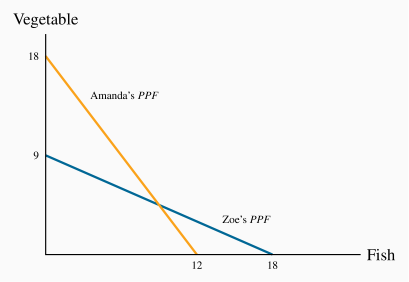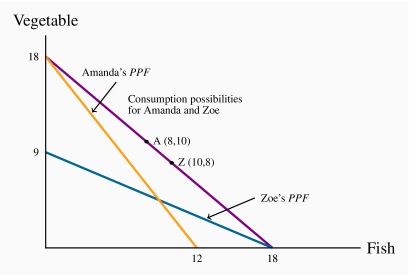Production and specialization
We have two producers and two goods: Amanda and Zoe produce vegetables (V) and or fish (F). Their production capabilities are defined in Table 1.1 and in Figure 1.1, where the quantity of V appears on the vertical axis and the quantity of F on the horizontal axis. Zoe and Amanda each have 36-hour weeks and they devote that time to producing the two goods. But their efficiencies differ: Amanda requires two hours to produce a unit of V and three hours for a unit of F. As a consequence, if she devotes all of her time to V she can produce 18 units, or if she devotes all of her time to F she can produce 12 units. Or, she could share her time between the two. This environment can also be illustrated and analyzed graphically, as in Figure 1.1.
Table 1.1 Production possibilities in a two-person economy
| |
Hours/ |
Hours/ |
Fish |
Vegetable |
| |
fish |
vegetable |
specialization |
specialization |
| Amanda |
3 |
2 |
12 |
18 |
| Zoe |
2 |
4 |
18 |
9 |
Each producer has a time allocation of 36 hours. By allocating total time to one activity, Amanda can produce 12F or 18V, Zoe can produce 18F or 9V. By splitting their time each person can also produce a combination of the two.
Two-dimensional graphics are a means of portraying the operation of a model, as defined above. We will use these graphical representations throughout the text. In this case, Amanda's production capability is represented by the line that meets the vertical axis at 18 and the horizontal axis at 12. The vertical point indicates that she can produce 18 units of V if she produces zero units of F – keep in mind that where V has a value of 18, Amanda has no time left for fish production. Likewise, if she devotes all of her time to fish she can produce 12 units, since each unit requires 3 of her 36 hours. The point F=12 is thus another possibility for her. In addition to these two possibilities, which we can term 'specialization', she could allocate her time to producing some of each good. For example, by dividing her 36 hours equally she could produce 6 units of F and 9 units of V. A little computation will quickly convince us that different allocations of her time will lead to combinations of the two goods that lie along a straight line joining the specialization points.
We will call this straight line Amanda's production possibility frontier (PPF): It is the combination of goods she can produce while using all of her resources – time. She could not produce combinations of goods represented by points beyond this line (to the top right). She could indeed produce combinations below it (lower left) – for example, a combination of 4 units of V and 4 units of F; but such points would not require all of her time. The (4,4) combination would require just 20 hours. In sum, points beyond this line are not feasible, and points within it do not require all of her time resources.
Production possibility frontier (PPF): the combination of goods that can be produced using all of the resources available.
Having developed Amanda's PPF, it is straightforward to develop a corresponding set of possibilities for Zoe. If she requires 4 hours to produce a unit of V and 2 hours to produce a unit of F, then her 36 hours will enable her to specialize in 9 units of V or 18 units of F; or she could produce a combination represented by the straight line that joins these two specialty extremes.
Consider now the opportunity costs for each person. Suppose Amanda is currently producing 18 V and zero F, and considers producing some F and less V. For each unit of F she wishes to produce, it is evident from her PPF that she must sacrifice 1.5 units of V. This is because F requires 50% more hours than V. Her trade-off is 1.5:1.0. The additional time requirement is also expressed in the intercept values: She could give up 18 units of V and produce 12 units of F instead; this again is a ratio of 1.5:1.0. This ratio defines her opportunity cost: The cost of an additional unit of F is that 1.5 units of V must be 'sacrificed'.
Applying the same reasoning to Zoe's PPF, her opportunity cost is 0.5:1; she must sacrifice one half of a unit of V to free up enough time to produce one unit of F.
So we have established two things about Amanda and Zoe's production possibilities. First, if Amanda specializes in V she can produce more than Zoe, just as Zoe can produce more than Amanda if Zoe specializes in F. Second, their opportunity costs are different: Amanda must sacrifice more V than Zoe in producing one more unit of F. The different opportunity costs translate into potential gains for each individual.
The gains from exchange
We shall illustrate the gains that arise from specialization and exchange graphically. Note first that if these individuals are self-sufficient, in the sense that they consume their own production, each individual's consumption combination will lie on their own PPF. For example, Amanda could allocate half of her time to each good, and produce (and consume) 6F and 9V. Such a point necessarily lies on her PPF. Likewise for Zoe. So, in the absence of exchange, each individual's PPF is also her consumption possibility frontier (CPF). In Figure 1.1 the PPF for each individual is thus also her CPF.
Consumption possibility frontier (CPF): the combination of goods that can be consumed as a result of a given production choice.
Upon realizing that they are not equally efficient in producing the two goods, they decide to specialize completely in producing just the single good where they are most efficient. Amanda specializes in V and Zoe in F. Next they must agree to a rate at which to exchange V for F. Since Amanda's opportunity cost is 1.5:1 and Zoe's is 0.5:1, suppose they agree to exchange V for F at an intermediate rate of 1:1. There are many trading, or exchange, rates possible; our purpose is to illustrate that gains are possible for both individuals at some exchange rate. The choice of this rate also makes the graphic as simple as possible. At this exchange rate, 18V must exchange for 18F. In Figure 1.2, this means that each individual is now able to consume along the line joining the coordinates (0,18) and (18,0). This is because Amanda produces 18V and she can trade at a rate of 1:1, while Zoe produces 18F and trades at the same rate of 1:1.
The fundamental result illustrated in Figure 1.2 is that, as a result of specialization and trade, each individual can consume combinations of goods that lie on a line beyond her initial consumption possibilities. Their consumption well-being has thus improved. For example, suppose Amanda trades away 8V to Zoe and obtains 8F in return. The points 'A' and 'Z' with coordinates (8,10) and (10,8) respectively define their final consumption. Pre-specialization, if Amanda wished to consume 8F she would have been constrained to consume 6V rather than the 10V now possible. Zoe benefits correspondingly.
The foregoing example illustrates that trade is not a zero-sum game; it has a positive net value because both parties to the trade can gain. A zero-sum gain is where the gains to one party exactly offset the losses to another. This is an extraordinarily important principle in trade negotiations, whether international or domestic.
A zero-sum game is an interaction where the gain to one party equals the loss to another party.
Market design
In the preceding example we have shown that specialization provides scope for gains that can accrue to those participating in the exchange. But this tells us little about how a market for these products comes into being: how does the exchange take place, and how is information transmitted? The answer is that while some markets have evolved historically to their current state, many markets are designed by an institution or a firm. Fruit and vegetable markets have been with us for thousands of years - since we ceased being purely a hunter-gatherer society. They exist in every community in the world economy. In contrast, the Dutch tulip auction was designed in the early 1600s and exists in basically the same form to this day: the auctioneer begins with a high price, lowers it at known time intervals (measured in seconds or minutes) until some buyer signals that she is willing to purchase the lot on offer. Supermarkets in contrast offer goods at a fixed price. Government contracts are normally signed after a tendering process, in which interested suppliers submit bids. Amazon Inc. is currently experimenting with cashierless 'bricks and mortar' stores that monitor all transactions electronically. Craig's List and E-Bay have their own sets of rules.
In each of these cases markets are designed, frequently with a specific objective on the part of the supplier or the mediating institution: Amazon wants to increase its share of all goods trades; governments wish to limit costs. Markets do not all grow spontaneously and the structure of a market will influence how the gains from trade are distributed.




